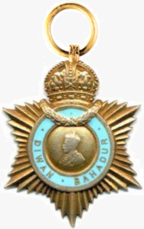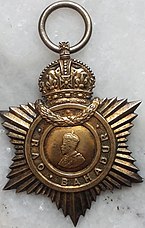Classes
There were three classes, each sub-divided to reflect the religion, and sometimes region, of the title holder. [1] [4]
First Class
Second Class
Third Class
Those of other religions received the title considered most appropriate, for example native Indian Christians with a Hindu sounding name would receive a Hindu title, [4] with Jews receiving a Muslim title. [5]
Title badges took precedence after all British and Indian orders and decorations, and before campaign medals. [2] In most cases, recipients proceeded from the lowest class to the higher grades, with only the most senior title, and badge, used. Ranking below a knighthood, these titles were dropped by any holder who became a knight of a British Order, for example the Order of the Star of India or the Order of the Indian Empire. [1]
Members of the first class of the Order of British India could also use the title of Sardar Bahadur, with members of the second class using Bahadur. [6] In these cases, the Title Badge was not worn.
Appearance
The badge consisted of a radiant star topped by an imperial crown, with a laurel wreath draped below the crown. A central medallion bore the appropriate title on a band surrounding the crowned profile of the king, either George V or George VI. Facing right until 1933, the design was then changed to show George V's bust facing left. The George VI version showed his bust facing left. [2]
The reverse was plain, and was engraved with the name and details of the recipient. [2]
All three classes were the same size: 58 millimetres (2.3 in) in height and 45 millimetres (1.8 in) wide, differentiated by their metal finish and ribbon: [1]
- 1st class: silver gilt with the title displayed on the central medallion enamelled pale blue. The ribbon was light blue edged with dark blue;
- 2nd class: silver gilt without enamel. The ribbon was red edged with dark red;
- 3rd class: silver with the title displayed on the central medallion enamelled dark blue. The ribbon was dark blue edged with light blue.
All three classes were worn around the neck from the 39 millimetres (1.5 in) wide ribbon, [1] although the badge was sometimes unofficially worn on the left chest alongside other medals. [lower-alpha 3]

The Order of Orange-Nassau is a civil and military Dutch order of chivalry founded on 4 April 1892 by the queen regent, Emma of the Netherlands.

The Royal Red Cross (RRC) is a military decoration awarded in the United Kingdom and Commonwealth for exceptional services in military nursing. It was created in 1883 and the first two awards were to Florence Nightingale and Jane Cecilia Deeble. Deeble had served in Zululand and she had noted that the work of the nurses was not recognised officially.
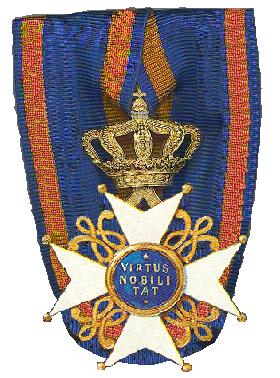
The Order of the Lion of the Netherlands, also known as the Order of the Netherlands Lion is a Dutch order of chivalry founded by King Willem I of the Netherlands on 29 September 1815.

The Royal Order of the Sword is a Swedish order of chivalry and military decoration created by King Frederick I of Sweden on 23 February 1748, together with the Order of the Seraphim and the Order of the Polar Star. The motto of the order is in Latin: Pro Patria.
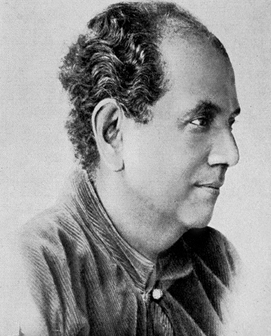
Abanindranath Tagore was the principal artist and creator of the "Indian Society of Oriental Art". He was also the first major exponent of Swadeshi values in Indian art. He founded the influential Bengal school of art, which led to the development of modern Indian painting. He was also a noted writer, particularly for children. Popularly known as 'Aban Thakur', his books Rajkahini, Buro Angla, Nalak, and Khirer Putul were landmarks in Bengali language children's literature and art.

The Royal Norwegian Order of Saint Olav is a Norwegian order of chivalry instituted by King Oscar I on 21 August 1847. It is named after King Olav II, known to posterity as St. Olav.

The Order of British India was an order of merit established in 1837 by the East India Company for "long, faithful and honourable service". The company's powers were removed after the Indian Mutiny, and the Order was incorporated into the British Honours System in 1859. The order became obsolete in 1947, after the partition of British India into the Dominion of India and the Dominion of Pakistan.

Nandalal Bose was one of the pioneers of modern Indian art and a key figure of Contextual Modernism.

Khan Sahib is a compound of Khan "Leader" and Sahib "Master" - was a formal title of respect and honour, which was conferred mainly on Muslim, but also to Parsi, Irani, and Jewish subjects of the British Indian Empire. It was a title one degree lower than Khan Bahadur, but higher than that of Khan.
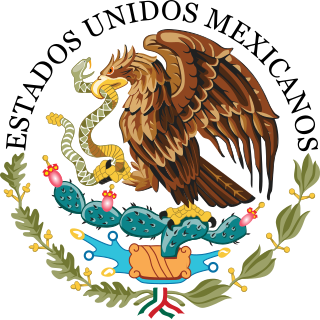
This is a list of military decorations awarded by the United Mexican States as part of the Mexican Honours System.

The Honoris Crux of 1952, post-nominal letters HC, is a military decoration for bravery which was instituted by the Union of South Africa in 1952. It was in use from 1952 to 1975 and was awarded to members of the South African Defence Force for gallantry in action against the enemy in the field. It was discontinued on 1 July 1975, when it was replaced by a new set of four Honoris Crux decorations, in four classes.

Rai Sahib / Rao Saheb / Roy Sahib / Rao Sahib abbreviated R.S., was a title of honour issued during the era of British rule in India to individuals who performed faithful service or acts of public welfare to the nation. From 1911 the title was accompanied by a special Title Badge. Translated, Rai means "King" Sahib means "Leader". Awarded during the reign of George VI. For another image of the badge see link This was the start level title usually awarded to civilians, which could later be upgraded to Rao Bahadur and then to Dewan Bahadur titles.
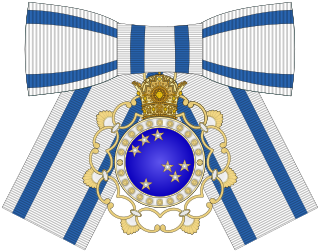
The Order of the Pleiades, also named Order of Haft Paykar, was an all-female order of the former Imperial State of Iran.
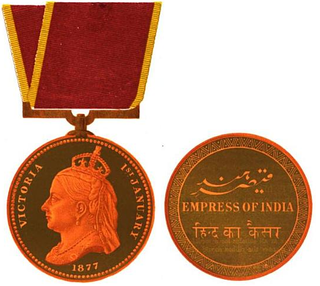
The Empress of India Medal, also referred to as KIH Medal, was a commemorative medal awarded to mark the occasion of the proclamation of Queen Victoria as Empress of India in 1877. It was the first wearable medal issued to mark a commemorative occasion within the British Empire. The medal was awarded in gold to Indian princes and senior officials and in silver to selected British and Indian military officers and civilians, as well as one soldier from each British and Indian regiment serving in India at the time of the proclamation celebrations of the 1877 Delhi Durbar.

The Most Illustrious Order of Queen Sālote Tupou III is a knighthood order of the Kingdom of Tonga.

The House Order of Henry the Lion In German: Hausorden Heinrichs des Löwen, was the House Order of the Duchy of Brunswick. It was instituted by William VIII, Duke of Brunswick on 25 April 1834. The ribbon of the Order was red with yellow edges. It had five grades: Grand Cross, Grand Commander with Sash, Commander, Knight 1st Class, Knight 2nd Class, plus Medal of Merit for Science and Arts, the Cross of Merit and the Medal of Honour. The Order was named in honour of Henry the Lion, who remains a popular figure to this day.
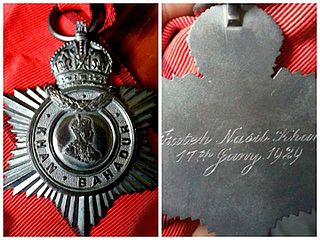
Khan Bahadur – a compound of Khan "Leader" and Bahadur "Brave" – was a honorary title in British India conferred on Indian subjects who were adherents of Islam or Zoroastrianism. The equivalent title for Hindus, Buddhists and Indian Christians was Rao Bahadur/Rai Bahadur and Sardar Bahadur for Sikhs. The title of Khan Bahadur was one degree higher than the title of Khan Sahib.
The Order of the Leopard is a merit order of the former Republic of Bophuthatswana. The Order was instituted in order to recognise service to the people of the Republic of Bophuthatswana. It was instituted by the President of the Republic of Bophuthatswana by official Warrant on 28 December 1979.
Sardar Bahadur was a title of honour awarded to native Indian civilians and Viceroy's commissioned officers during British rule in India. It was bestowed upon Sikhs, and was awarded for faithful service or acts of public welfare. The title was used after any military rank, but before the title holder's name. From 1911 holders of the title were also awarded a special Title Badge.
With the inception of Company rule in India by the East India Company in 1757, the tradition of giving medals also began. Campaign medals and awards were given to soldiers who fought in the Company's presidency armies. After 1895, with the formation of British Indian Army, soldiers were awarded with gallantry awards alongside Imperial Service Troops of the princely states. Awards were also bestowed upon the personnel of Royal Indian Navy and of Royal Indian Air Force with its incorporation in 1932. Indian Imperial Police were also eligible for the police honours.
The company's powers were removed in 1858 after the Indian Mutiny, and the British Crown assumed direct control of India and monarch took the title of Emperor of India in 1876. During the British Raj, new medals and orders were established and were awarded for the services to the Crown and the Indian Empire by Europeans and Indians of British India and the princely states. After 1914, Indians also became eligible for British Honours. The following is a list of orders, decorations and medals related to British in India:
